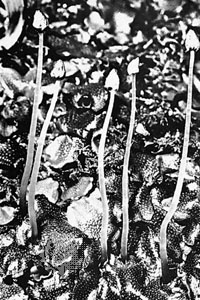liverwort
plant
(class Hepatopsidae), any of more than 8,000 species of small, nonvascular, spore-producing land plants constituting part of the division Bryophyta. They include the thallose liverworts that show branching, ribbonlike gametophytes and the leafy liverworts (leafy liverwort) (mainly in the order Jungermanniales). The six orders of liverworts are segregated primarily on gametophyte structures, with sporophyte features also supporting the classification. One additional order formerly classified as liverworts (Takakiales) is now placed among the mosses.
 Liverworts are distributed worldwide, though most commonly in the tropics. Thallose liverworts grow commonly on moist soil or damp rocks, while leafy liverworts are found in similar habitats as well as on tree trunks in damp woods. The thallus of thallose liverworts resembles a lobed liver—hence the common name liverwort (“liver plant”). Filamentous structures called rhizoids anchor most liverworts to their substrata, except for the few genera that are aquatic.
Liverworts are distributed worldwide, though most commonly in the tropics. Thallose liverworts grow commonly on moist soil or damp rocks, while leafy liverworts are found in similar habitats as well as on tree trunks in damp woods. The thallus of thallose liverworts resembles a lobed liver—hence the common name liverwort (“liver plant”). Filamentous structures called rhizoids anchor most liverworts to their substrata, except for the few genera that are aquatic.Sexual ( gametophyte) and asexual ( sporophyte) generations characterize a liverwort life cycle. The gametophyte generation develops from a germinating spore. Sperm from the male reproductive organ (antheridium) travel through an aqueous environment, and one sperm fertilizes an egg that is still retained in the female reproductive organ (archegonium). The sporophyte develops from this embryo and forms a sporangium at its apex. Spores are released when the sporangium ruptures, marking the start of a new gametophytic generation. Asexual reproduction occurs by means of gemmae, which are produced by the gametophytic generation or by separation of branches of that plant body, resulting in new plants.
Liverworts are not economically important to humans but do provide food for animals, facilitate the decay of logs, and aid in the disintegration of rocks by their ability to retain moisture.
The most ancient liverwort fossil—Pallaviciniites devonicus, thought to be a member of the order Metzgeriales—dates to the Upper Devonian Period (about 385 to 359 million years ago). It resembles a thallose liverwort.
- Parc National de Taï
- pardalote
- Pardo Bazán, Emilia, Countess de
- pardon
- Pardubice
- Parecis Mountains
- paregoric
- Pareja, Juan de
- Pare Lorentz
- parenchyma
- parent
- Parentalia
- paresis
- Pareto, Vilfredo
- Paretsky, Sara
- pareve
- parfleche
- Parhae
- parhelion
- Paria, Gulf of
- pariah
- Parian Chronicle
- Parian ware
- Paricutín
- Paridae